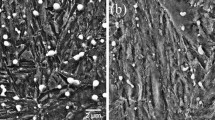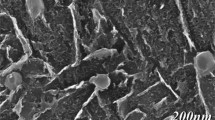Abstract
The friction and wear behaviors of a new hot-work die steel, SDCM-SS, were studied at high temperature under dry air conditions. The wear mechanism and microstructural characteristics of the SDCM-SS steel were also investigated. The results showed that the SDCM-SS steel had greater wear resistance compared with H13 steel; this was owed to its high oxidizability and temper stability. These features facilitate the generation, growth, and maintenance of a tribo-oxide layer at high temperature under relatively stable conditions. The high oxidizability and thermal stability of the SDCM-SS steel originate from its particular alloy design. No chromium is added to the steel; this ensures that the material has high oxidizability, and facilitates the generation of tribo-oxides during the sliding process. Molybdenum, tungsten, and vanadium additions promote the high temper resistance and stability of the steel. Many fine Mo2C and VC carbides precipitate during the tempering of SDCM-SS steel. During sliding, these carbides can delay the recovery process and postpone martensitic softening. The high temper stability postpones the transition from mild to severe wear and ensures that conditions of mild oxidative wear are maintained. Mild oxidative wear is the dominant wear mechanism for SDCM-SS steel between 400 and 700 °C.















Similar content being viewed by others
References
O. Barrau, C. Boher, R. Gras, and F. Rezai-Aria, Analysis of the Friction and Wear Behaviour of Hot Work Tool Steel for Forging, Wear, 2003, 255, p 1444–1454
C. Boher, S. LeRoux, L. Penazzi, and C. Dessain, Experimental Investigation of the Tribological Behavior and Wear Mechanisms of Tool Steel Grades in Hot Stamping of a High-Strength Boron Steel, Wear, 2012, 294–295, p 286–295
M.X. Wei, F. Wang, S.Q. Wang, and X.H. Cui, Comparative Research on the Elevated-Temperature Wear Resistance of a Cast Hot-Working Die Steel, Mater. Des., 2009, 30, p 3608–3614
G.A. Fontalvo and C. Mitterer, The Effect of Oxide-Forming Alloying Elements on the High Temperature Wear of a Hot Work Steel, Wear, 2005, 258, p 1491–1499
P.J. Blau, Elevated-Temperature Tribology of Metallic Materials, Tribol. Int., 2010, 43, p 1203–1208
M. Pellizzari, D. Cescato, and M.G. DeFlora, Hot Friction and Wear Behaviour of High Speed Steel and High Chromium Iron for Rolls, Wear, 2009, 267, p 467–475
S. Hernandez, J. Hardell, H. Winkelmann, M.R. Ripoll, and B. Prakash, Influence of Temperature on Abrasive Wear of Boron Steel and Hot Forming Tool Steels, Wear, 2015, 338–339, p 27–35
X.H. Cui, S.Q. Wang, F. Wang, and K.M. Chen, Research on Oxidation Wear Mechanism of the Cast Steels, Wear, 2008, 265, p 468–476
E. Marui, N. Hasegawa, H. Endo, K. Tanaka, and T. Hattori, Research on the Wear Characteristics of Hypereutectoid Steel, Wear, 1997, 205, p 186–199
S.Q. Wang, M.X. Wei, F. Wang, and Y.T. Zhao, Transition of Elevated-Temperature Wear Mechanisms and the Oxidative Delamination Wear in Hot-Working Die Steels, Tribol. Int., 2010, 43, p 577–584
F.H. Stott, J. Glascott, and G.C. Wood, Factors Affecting the Progressive Development of Wear-Protective Oxides on Iron-Base Alloys During Sliding at Elevated Temperatures, Wear, 1984, 97, p 93–106
T.F.J. Quinn, Review of Oxidational Wear Part I: The Origins of Oxidational Wear, Tribol. Int., 1983, 16, p 257–271
T.F.J. Quinn, Review of Oxidational Wear part II: Recent Developments and Future Trends in Oxidational Wear Research, Tribol. Int., 1983, 16, p 305–315
J. Archard., W. Hirst, The wear of metals under unlubricated conditions, Proceedings of the Royal Society A: Mathematical, Physical and Engineering Sciences, 1956, p 397–410
S.M. Hsu, M.C. Shen, and A.W. Ruff, Wear Prediction for Metals, Tribol. Int., 1997, 30, p 377–383
S.Q. Wang, L. Wang, Y.T. Wang, Y. Sun, and Z.R. Yang, Mild-to-Severe Wear Transition and Transition Region of Oxidative Wear in Steels, Wear, 2013, 306, p 311–320
H. Kato, Severe-Mild Wear Transition by Supply of Oxide Particles on Sliding Surface, Wear, 2003, 255, p 426–429
C.C. Viáfara and A. Sinatora, Influence of Hardness of the Harder Body on Wear Regime Transition in a Sliding Pair of Steels, Wear, 2009, 267, p 425–432
S.Q. Wang, M.X. Wei, F. Wang, X.H. Cui, and C. Dong, Transition of Mild Wear to Severe Wear in Oxidative Wear of H21 Steel, Tribol. Lett., 2008, 32, p 67–72
S.Q. Wang, M.X. Wei, and Y.T. Zhao, Effects of the Tribo-Oxide and Matrix on Dry Sliding Wear Characteristics and Mechanisms of a Cast Steel, Wear, 2010, 269, p 424–434
S.C. Lim, The Relevance of Wear-Mechanism Maps to Mild-Oxidational Wear, Tribol. Int., 2002, 35, p 717–723
A.W. Batchelor, G.W. Stachowiak, and A. Cameron, The Relationship Between Oxide Films and the Wear of Steels, Wear, 1986, 113, p 203–223
F.H. Stott, The Role of Oxidation in the Wear of Alloys, Tribol. Int., 1998, 31, p 61–71
G. Straffelini, D. Trabucco, and A. Molinari, Oxidative Wear of Heat-Treated Steels, Wear, 2001, 250, p 485–491
Q.Y. Zhang, K.M. Chen, L. Wang, X.H. Cui, and S.Q. Wang, Characteristics of Oxidative Wear and Oxidative Mildwear, Tribol. Int., 2013, 61, p 214–223
S.Q. Wang, F. Wang, K. Chen, and X.H. Cui, A Newly-Developed High Wear Resistant Cast Hot-Forging Die Steel, ISIJ Int., 2007, 47, p 1335–1340
N. Mebarki, D. Delagnes, P. Lamesle, F. Delmas, and C. Levaillant, Relationship Between Microstructure and Mechanical Properties of A 5% Cr Tempered Martensitic Tool Steel, Mater. Sci. Eng. A, 2004, 387–389, p 171–175
Q.C. Zhou, X.C. Wu, N.N. Shi, J.W. Li, and N. Min, Microstructure Evolution and Kinetic Analysis of DM Hot-Work Die Steels During Tempering, Mater. Sci. Eng. A, 2011, 528, p 5696–5700
P. Michaud, D. Delagnes, P. Lamesle, M.H. Mathon, and C. Levaillant, The Effect of the Addition of Alloying Elements on Carbide Precipitation and Mechanical Properties in 5% Chromium Martensitic Steels, Acta Mater., 2007, 55, p 4877–4889
A. Medvedeva, J. Bergström, S. Gunnarsson, and J. Andersson, High-Temperature Properties and Microstructural Stability of Hot-Work Tool Steels, Mater. Sci. Eng. A, 2009, 523, p 39–46
M.X. Wei, S.Q. Wang, K.M. Chen, and X.H. Cui, Relations Between Oxidative Wear and Cr Content of Steels, Wear, 2011, 272, p 110–121
F.H. Stott and G.C. Wood, The Influence of Oxides on the Friction and Wear of Alloys, Tribol. Int., 1978, 11, p 211–218
Y. Wang, T. Lei, and J. Liu, Tribo-Metallographic Behavior of High Carbon Steels in Dry Sliding: III. Dynamic Microstructural Changes and Wear, Wear, 1999, 231, p 20–37
V. Abouei, H. Saghafian, and S. Kheirandish, Effect of Microstructure on The Oxidative Wear Behavior of Plain Carbon Steel, Wear, 2007, 262, p 1225–1231
J.L. Sullivan, T.F.J. Quinn, and D.M. Rowson, Developments in the Oxidational Theory of Mild Wear, Tribol. Int., 1980, 13, p 153–158
M.X. Wei, S.Q. Wang, L. Wang, X.H. Cui, and K.M. Chen, Effect of Tempering Conditions on Wear Resistance in Various Wear Mechanisms of H13 Steel, Tribol. Int., 2011, 44, p 898–905
N. Saka, J.J. Pamies-Teixeira, and N.P. Suh, Wear of Two-Phase Metals, Wear, 1977, 44, p 77–86
M. Vardavoulias, The Role of Hard Second Phases in the Mild Oxidational Wear Mechanism of High-Speed Steel-Based Materials, Wear, 1994, 173, p 105–114
Acknowledgments
This work supported by the National Natural Science Foundation of China (Grant Nos. 51401117 and 51171104). The authors would like to thank Na. Min from Instrumental Analysis and Research Center of Shanghai University for the help with the TEM measurements.
Author information
Authors and Affiliations
Corresponding author
Rights and permissions
About this article
Cite this article
Li, S., Wu, X., Chen, S. et al. Wear Resistance of H13 and a New Hot-Work Die Steel at High temperature. J. of Materi Eng and Perform 25, 2993–3006 (2016). https://doi.org/10.1007/s11665-016-2124-2
Received:
Revised:
Published:
Issue Date:
DOI: https://doi.org/10.1007/s11665-016-2124-2




